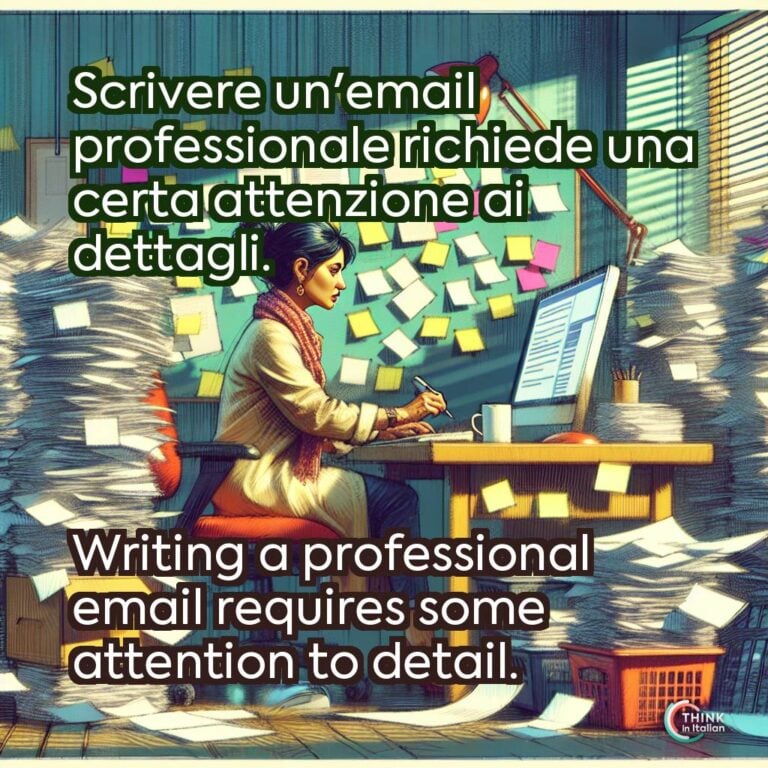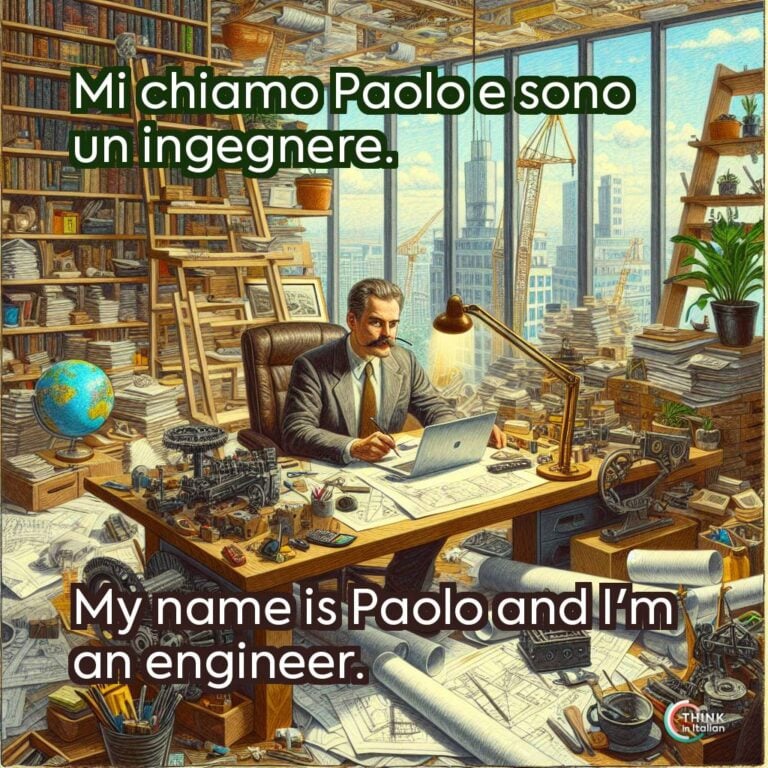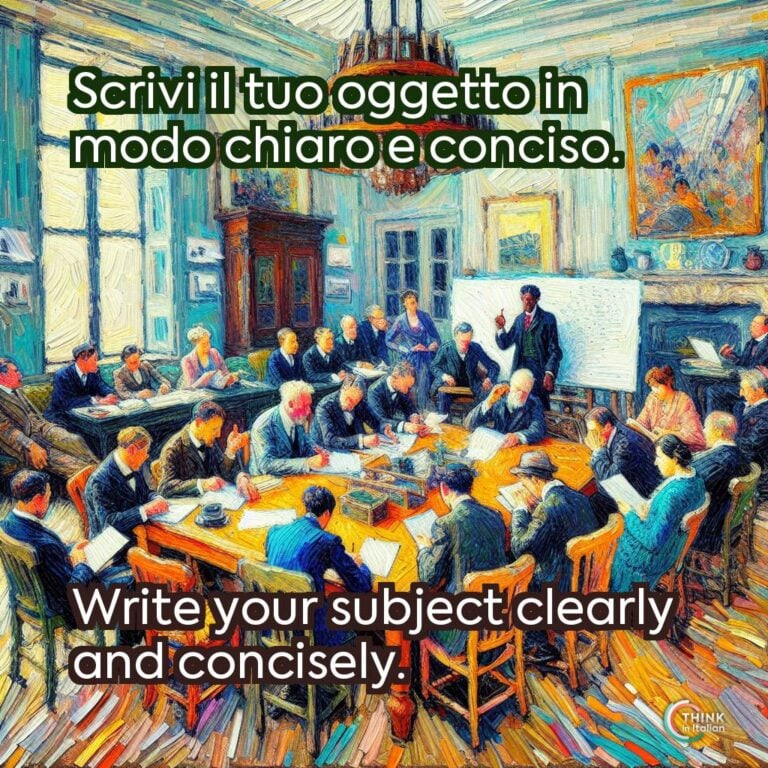How To Start An Email In Italian
If you’re planning to learn Italian for business or for studying, then you should know how to write an email. As all texts, emails have a specific structure.
In this guide I will teach you different types of Italian openings and closing formulas, and greetings for both formal and informal emails.
First of all, keep in mind the subject of your email. In Italian it usually is a noun or a noun and an adjective: for instance, riunione (meeting), ordine smarrito (lost order)…
Once you have that clear, think who you are addressing the email to – il destinatario (the recipient) – and then you are ready to start writing an email in Italian!
Opening Formulas
Informal Emails
Openings change a lot depending on who you are writing to. If you are addressing a friend or someone you know well, you can use the following opening formulas:
Caro/Cara (nome)
Dear (name)
Ciao
Hi
Buongiorno
Good morning/afternoon
Buonasera
Good evening
Formal Emails
If you do not know the person you’re writing to or you are writing to a superior, like for a job application or your boss, you can use adjectives like gentile or egregio/ egregia followed by either:
- The title of the person: Italians love their titles, so it is important to mention them, even in an email! If the addressee has a title you know of, use these abbreviations:
- Dott. / Dot.ssa (dottore / dottoressa): a doctor or anyone with a degree
- Avv. (avvocato): lawyer
- Ing. (ingegnere): engineer
- Arch. (architetto): architect
- Rag. (ragioniere): accountant
- The abbreviation Sig. (Signore – Mr.) or Sig.ra (Signora – Mrs.) followed by their surname;
Gentile direttore / Gentile insegnante
Dear director/ Dear teacher
Gentile Sig. Bellini / Gentile Sig.ra Bellini
Dear Mr. Bellini / Dear Mrs. Bellini
Egregio professore / Egregia professoressa
Dear director/ Dear teacher
Egregio Ing. Rossi
Dear Engineer Rossi
If you want to be neutral, you can say
A chi di competenza
To whom it may concern
With the name of a business, use Spettabile (Respectable). For example: Spettabile Scuola di Italiano.
Introduction
In order to write a well-organized email, I advise you to follow the standard structure where you first introduce the topic of your email. As I mentioned before, you should have already written the subject at this point, so think of the introduction as an explanation of the subject.
Here I will show you the most common phrases to write an introduction in an Italian email. Notice that whether the email is written with a formal or informal tone depends on the way you address your recipient. Therefore, do not forget how to use the formal Lei in Italian.
Also notice that I highlighted the prepositions in the sentences below to show you what to use in what context, since the use of Italian prepositions differs from that of English ones.
So, now let me show you how you can use these expressions:
- To introduce yourself:
Sono Michael.
I’m Michael.
Mi chiamo Allison Bay.
My name is Allison Bay.
Mi chiamo Robert Nash e sono un ingegnere elettronico.
My name is Robert Nash, and I’m an electronic engineer.
- To thank for an exchange of emails:
Grazie per la tua/sua email.
Thanks for your email.
Ti/La ringrazio per avermi scritto.
Thank you for writing to me.
- To apologize for something:
Scusa/Scusi se non ho risposto prima.
I’m sorry I didn’t answer before; I was very busy.
Scusa/Scusi per la email precedente.
Sorry for the previous email.
- To elicit the reason why you are writing:
Ti/Le scrivo per …
I am writing you to…
These expressions are quite neutral, meaning that you can use them in both informal and formal context. However, if you’re writing a very formal message, you might need some specific formulas:
Le scrivo in riferimento a …
I am writing with regard to …
Come anticipato precedentemente …
As stated previously …
In risposta alla Sua mail…
Answering your email…
Con la presente …
I hereby …
Body
It is now the moment of the body of the email, which is the main part of your email. In this section, there isn’t much to say because it really depends on what you need to express.
However, I want to make sure you remember to keep the formal or informal tone throughout the entire email. Therefore, if you are writing formally, do not forget to write verbs and pronouns in the third person singular!
Also, these two expressions might be useful when writing the body of you emails:
In allegato …
Attached…
Allego…
I am attaching
Closing Formulas
Informal
In informal emails, you can easily greet your recipient with something like:
Fammi sapere
Let me know
Un abbraccio
A hug
A presto
See you/Write soon
Saluti
Greeting
Formal
To close a formal email, you can either simply greet in a formal way, or you can use the fixed and standard formal formulas. In the first case, you can write:
Distinti saluti / Cordiali saluti
Best regards
Cordialmente
[lit.] Kindly
In the second case, which is usually when the communication is highly formal, you can use one of these expressions which all serve the same purpose even if they have slightly different literal meanings. Remember to include one of the previously mentioned closing formulas right after.
In attesa di riscontro, resto a disposizione per chiarimenti e porgo cordiali saluti
[lit.] While waiting for feedback, I remain available for clarification and I offer cordial greetings.
In attesa di un Suo cortese riscontro.
[lit.] Waiting for your kind feedback.
Ringraziando per l’attenzione.
Thanking for your attention.
Emails in Italian: Examples and Translation
Informal Email
Ciao Maria,
Spero che tu stia bene! Volevo solo scriverti per ringraziarti ancora per il fantastico pranzo di sabato scorso. Le tue abilità culinarie sono davvero straordinarie! È stato così bello passare del tempo insieme e gustare quelle prelibatezze italiane autentiche.
Ho pensato che potremmo pianificare un’altra serata del genere presto. Magari possiamo organizzare una cena a casa mia e cucinare insieme qualche piatto italiano. Che ne dici?
Fammi sapere se sei disponibile e possiamo fissare una data. Non vedo l’ora di ripetere questa esperienza!
Un abbraccio, Luca
Hi Maria,
I hope you’re doing well! I just wanted to write and thank you again for the fantastic lunch last Saturday. Your culinary skills are truly extraordinary! It was so nice to spend time together and savor those authentic Italian delicacies.
I thought we could plan another evening like that soon. Maybe we could arrange a dinner at my place and cook some Italian dishes together. What do you think?
Let me know if you’re available, and we can set a date. I can’t wait to repeat this experience!
Formal Email
Oggetto: Richiesta di Informazioni sul Progetto di Collaborazione
Gentile [Nome Destinatario],
Mi chiamo [Tuo Nome] e sono [La tua posizione o affiliamento, se necessario] presso [Nome della tua azienda o istituzione]. Scrivo per richiedere ulteriori informazioni riguardo al progetto di collaborazione menzionato durante l’ultima conferenza tenutasi a [Luogo] il [Data].
Sarei molto interessato/a a comprendere meglio i dettagli del progetto, inclusi gli obiettivi, le tempistiche e le eventuali opportunità di coinvolgimento. Gradirei inoltre sapere se è previsto un incontro o una presentazione dettagliata per discutere approfonditamente i termini e le modalità di questa collaborazione.
Sono disponibile per un incontro telefonico o una riunione di persona, in base alla vostra convenienza. Vi prego di farmi sapere se è possibile organizzare un appuntamento al fine di discutere in dettaglio questa prospettiva di collaborazione.
Resto in attesa di un vostro cortese riscontro e vi ringrazio anticipatamente per l’attenzione che vorrete dedicare alla mia richiesta.
Cordiali saluti,
[Tuo Nome] [Tua Posizione] [Nome della Tua Azienda o Istituzione] [Contatti: Indirizzo email e numero di telefono]
Dear [Recipient’s Name],
My name is [Your Name], and I am [Your Position or Affiliation, if necessary] at [Your Company or Institution’s Name]. I am writing to request further information regarding the collaboration project mentioned during the last conference held in [Location] on [Date].
I am very interested in gaining a better understanding of the project details, including the objectives, timelines, and any potential opportunities for involvement. Additionally, I would like to inquire if there is a scheduled meeting or a detailed presentation to thoroughly discuss the terms and modalities of this collaboration.
I am available for a phone call or an in-person meeting, according to your convenience. Please let me know if it is possible to arrange an appointment to discuss this collaboration prospect in detail.
I am looking forward to your kind response and thank you in advance for considering my request.
Best regards,
[Your Name] [Your Position] [Your Company or Institution’s Name] [Contact Information: Email Address and Phone Number]






